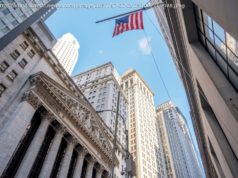 Asia markets were in the green as investors cheered better than expected Japanese exports data and South Korean GDP figures.
Asia markets were in the green as investors cheered better than expected Japanese exports data and South Korean GDP figures.
Markets in the region also took a positive lead from Wall Street after S&P 500 hit an all-time high over President Donald Trump’s executive orders to make it easier for TransCanada to build the Keystone XL pipeline and for Energy Transfer Partners to build the final potion of the Dakota Access pipeline.
The two pipelines have been fiercely disputed and had been delayed under the former President. Shares of Energy Transfer Partners and TransCanada both jumped more than 3.5 percent on Tuesday in the U. S..
Japan’s Nikkei 225 advanced 1.16 percent, with a broad-based rally across all sectors.
Japan’s annual exports grew in December for the first time in 15 months, led by shipments of car parts and electronics, Reuters reported. Exports in December were up 5.4 percent from the previous year, significantly better than the Reuters poll of economist forecasting a 1.2 percent increase.
Shares of Takata advanced 18.22 percent to hit its daily price limit of 80 yen (0.70 U. S. cents) per share. The Japanese airbag maker stock had fallen 40 percent since a week ago, over concerns of court involvement in its Japanese business plans.
In Australia, the benchmark ASX 200 was up 0.38 percent, led by its materials sub-index, which was up 1.78 percent.
«The story in Australia is clearly around the moves in commodities and the materials sector,» said Chris Weston, chief market strategist at IG, in a note on Wednesday. Weston expects the ASX 200 materials sub-index will break out to the highest levels since August 2014.
Major miner Rio Tinto was up 3.1 percent, after it announced Tuesday that it has agreed to sell its Australian unit Coal & Allied Industries to China’s Yancoal Australia for up to $2.45 billion, Reuters reported. Other major Australian miners were also positive, with Fortescue Metals up 0.15 percent and BHP Billiton gaining 3.26 percent.
Meanwhile, Australia’s inflation rose less than expected in the last quarter of 2016, up 0.5 percent in the fourth-quarter and 1.5 percent from the previous year. The Reserve Bank of Australia targets an annual inflation rate in the range between 2 to 3 percent.
South Korea benchmark, the Kospi index, added 0.1 percent after its the Bank of Korea showed that fourth-quarter gross domestic product (GDP) rose 0.4 percent from the previous quarter, and 2.3 percent on-year. A Reuters poll had estimated growth to rise by 0.3 percent in the final quarter.
Over in China, the Shanghai composite traded up 0.23 percent and the Shenzhen composite gained 0.461 percent. Hong Kong’s Hang Seng was up 0.17 percent.
An MSCI top executive told Reuters Tuesday that China’s progress towards full inclusion of its stocks in global benchmarks could stop in its tracks, if it continues to tighten capital controls and prevent people from moving money out of the country.
Beijing’s tightening capital controls comes as a bid to stabilize its currency, which has been under pressure against the stronger dollar. The onshore yuan fell almost 7 percent against the dollar in 2016, its biggest decline since 1994.
Overnight during U. S. hours, Alibaba Group reported a 54 percent growth in third-quarter revenue, boosted by higher sales during the Single’s Day shopping event. The Chinese e-commerce giant saw revenue at 53.25 billion yuan ($7.67 billion) for the quarter ended Dec. 31, beating Reuters poll of analysts forecast of 50.10 billion yuan. Alibaba shares were up 3.07 percent at $101.43 each.
Taiwan’s stock market will be shut from today until Feb. 2.
After Trump tweeted that he will take executive action to build a wall along the U. S.-Mexico border, the Mexican peso fell slightly.
The proposed wall was a signature campaign promise that had heightened tensions with America’s southern neighbor, particularly as Trump has repeatedly claimed, over Mexico’s many objections, that Mexico would be forced to pay for the construction.
Prior to the tweet, the U. S. dollar was fetching around 21.4850 pesos and after it was sent, it was garnering as many as 21.569 Mexican pesos by 11:55 pm HK/SIN. That’s still below the record high levels over 22 pesos touched earlier this month.
In the broader currency market, the greenback remained at the 100 handle against a currency basket, at 100.25. The yen was stronger against the dollar, at 113.56 compared to levels above 114 last week, as the Australian dollar held steady at $0.7543.
During Asian hours, Brent futures slipped 0.4 percent to $55.23 per barrel, while U. S. crude dipped 0.47 percent to $52.94 as weekly inventory data from the American Petroleum Institute showed that U. S. crude, gasoline and diesel stocks rose last week.
Stateside, the S&P 500 index rose 0.66 percent to close at 2,280.07, reaching an intraday and closing record , with materials leading eight sectors higher, while the Dow Jones industrial average was up 0.57 percent at 19,912.71, and the Nasdaq composite gained 0.86 percent to close at 5,600.96.






